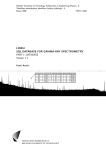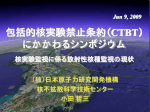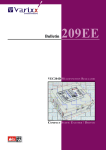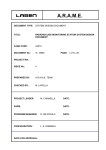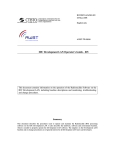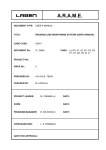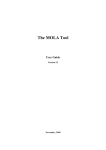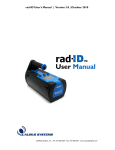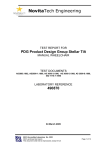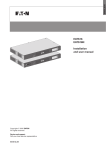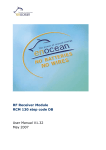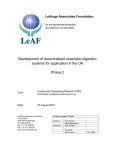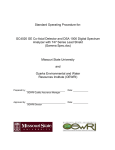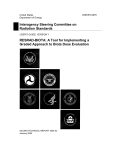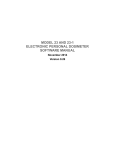Download Terms of Reference:
Transcript
ANNEX C TERMS OF REFERENCE FOR DEVELOPMENT OF RADIONUCLIDE OPERATIONS SOFTWARE 1. INTRODUCTION The Preparatory Commission for the Comprehensive Nuclear-Test Ban Treaty Organization (hereinafter referred to as the “Commission”) is responsible for the supervision and coordination of network operations and providing assistance for the proper functioning of all facilities of the International Monitoring System (IMS). The Commission ensures the operation of the IMS by concluding arrangements, agreements or contracts with Station Operators. Daily monitoring of the status of the IMS Radionuclide (RN) monitoring network and providing necessary support for station incident trouble-shooting is one of the coordination tasks between the Commission and the station operator. The overall design principle of the radionuclide operations software (hereinafter referred to as RN-OPS) is that it will be an integrated view of station status and International Data Centre (IDC) result. It will collect data from stations, IDC processing results and products, integrating these heterogeneous data into one single view. This integrated view will focus on metrics to support the operation of the Radionuclide Monitoring network. The project aims to provide a single tool that will allow the IMS/IDC responsible radionuclide staff to determine the status of the main components of the radionuclide network at any time. 2. 2.1. OVERVIEW OF THE RADIONUCLIDE MONITORING NETWORK Radionuclide Network The radionuclide portion of the International Monitoring System of the Commission verification regime consists of global networks of radionuclide monitoring stations and radionuclide laboratories. The network to measure radionuclides in the atmosphere consists of 80 stations equipped with samplers for airborne particulate monitoring. In addition, 40 of the 80 stations will be capable of monitoring radioactive noble gases. As of February 2010, 58 Particulate stations have been certified to enter into provisional operations. 24 Noble Gas systems have been under testing and evaluation phase, some of them will start certification process in 2010. Data from the radionuclide stations are transmitted directly or through a National Data Centre or an appropriate communication node to the International Data Centre (IDC). Page 1 of 17 - Request for Proposal No: 2010-0201 - TOR for Development of Radionuclide Operations Software 2.2. Operation Concept of the Radionuclide Network Data from Radionuclide stations are sent to IDC through the Global Communication Infrastructure (GCI) as messages using normal Emails. All messages are formatted subject to the IDC formats and Protocols. IDC checks the contents of the messages, parses the data type of the messages, and stores the message information in both IDC Oracle databases and file system. 2.2.1. Message types There are four types (PHD, MET, SOH, and ALERTS) of Radionuclide data formatted according to IDC formats and protocols (Attachment II) sent from a station through normal email system. Daily spectral data, also referred to as PHD data (QCPHD, PRELPHD, FULLPHD) QCPHD: Quality Control spectrum, 15-minute count of an appropriate gammaray source, one QC spectrum every day, before start of sample acquisition; PRELPHD: Preliminary spectra, One spectrum every 2 hours (2,4,6,8,10,12,14,16,18,20,22h), usually 11 spectra every day (sometimes it is possible to have more, like a PREL24 or even PREL30); FULLPHD: full sample spectrum, spectrum with acquisition time ≤ 24h, one full spectrum every day; GASBKPHD: Full gas background spectrum from SAUNA and ARIX noble gas system, one full spectrum every day. Non-daily spectral data (DETBKPHD, BLANKPHD, CALIBPHD) DETBKPHD: Detector background, acquired initially and whenever necessary BLANKPHD: Blank filter spectrum, acquired for each new batch of filters and when necessary CALIBPHD: Calibration spectrum, performed when necessary Non-spectral data SOH: State-of-health data, parameters are measured every 10 minutes and recorded into a file, which is transmitted every 2 hours; MET: Meteorological data, parameters are measured every 10 minutes and recorded into a file, which is transmitted every 2 hours; Alerts (a) Alerts are generated in the station indicating a system problem or warning for possible failure and sent to IDC whenever it is generated. Page 2 of 17 - Request for Proposal No: 2010-0201 - TOR for Development of Radionuclide Operations Software 2.2.2. Data processing All messages are parsed and saved in IDC databases and made available to subscribers. Spectra data will be processed and reviewed. Automatic Processing Reports and Review Reports will be produced as IDC products, saved at IDC database, from where they can be accessed. Please find the radionuclide pipeline figure 1. Figure 1 Radionuclide data processing pipeline 2.2.3. Network operations As illustrated in Appendix I, all parameters of RN data from IMS stations should be parsed and saved in IDC data bases. Raw SOH data will be monitored by Operations centre (OPS centre) and reviewed by responsible radionuclide staff (RISM), and PHD data will go through automatic processing and interactive reviewing. With alert management tool in OPS centre, major parameters of the incoming SOH data and quality of spectra (by checking results of automatic processing) will be monitored in OPS centre. If an incident is identified by OPS centre either with data outage or SOH/PHD quality, a problem report will be opened. Data outages related to station power issue or GCI link problems will be managed by OPS Centre duty staff for resolution. Incident related to data quality issues will be automatically assigned to IDC responsible staff member (RISM) for review. RISM will then review the SOH data and provide comments to analyst if he/she believes that the spectrum is still useful but some consideration need to be taken by analyst when reviewing the spectrum. Meaningless/bad Page 3 of 17 - Request for Proposal No: 2010-0201 - TOR for Development of Radionuclide Operations Software spectrum will be flagged by RISM and removed from further analyst review. RISM will further check with station operator for any possible causes and call for troubleshooting actions. All incidents will be tracked using existing reporting system. 2.3. Network QA/QC and Level 5 Sample Management The purpose of a QA/QC programme is to verify station performance, i.e. to ensure that data produced is of acceptable quality, the station is working within its certified operational specifications, and to initiate corrective action if non-conformances are found and preventive actions to avoid non-conformances. During operations of certified IMS particulate stations, the basis of the station QA/QC system is station operations according to the station specific operational manual and the QA/QC procedures therein. At the Commission, basic QA/QC functions for station operations include monitoring of station performance and SOH status. An additional component of station QA/QC is verification of station performance—specific key measurements—by independent measurements of samples sent to laboratories. QC samples are randomly selected from station samples that have been reviewed and categorized. It is usually one sample per quarter from each certified station. All selected QC samples meet the minimum requirements of IMS radionuclide station specifications. When multiple anthropogenic radionuclides are identified by IDC in a sample, this sample is categorized as Level 5 sample. As a rule, all Level 5 samples from certified stations are split and sent to laboratories for re-analysis, to exercise and maintain the procedures and practices for handling Level 5 samples for Treaty verification purposes. As illustrated in Appendix II, sample dispatch to Laboratories is initiated by a “Send_sample” Command which the Commission sends to the Station Operator. Station operator will ship the sample to laboratories and provide transportation information. Laboratory will analyze the sample and provide the result through a RLR message. After analysis, samples will be sent back to the Commission for archival. The whole process for sample delivery and measurement is managed through the command and control system. The current laboratory operations software at the Commission has the major functions related to QC/L5 sample management. The software should be migrated to the RN-OPS software in the future. 3. SCOPE OF THE WORK (a) The Contractor shall produce the software and a user manual according to the work tasks described in Section 4 and requirements in Section 5. Page 4 of 17 - Request for Proposal No: 2010-0201 - TOR for Development of Radionuclide Operations Software (b) The Contractor shall provide the Commission with the source code of the software. (c) The Contractor shall be prepared to correct errors as reported by the Commission during the warranty period. The work will be conducted at the premises of the Contractor’s headquarters and may include periods of work at the premises of the Commission in Vienna, Austria. Some of the software functions already exist in one form or another, within the existing software and procedures at the Commission. Performance Report Tool, developed by Evaluation Section, could possibly be used for station performance evaluation in some way. To what extent the existing utilities can be used is largely up to the implementers. Some interfacing with these systems might be necessary. 4. WORK TASKS 4.1. Software Design and Implementation (a) The Contractor shall produce, under the guidance of the Commission’s appointed staff, the design and functionalities of the RN-OPS software, and the design of the GUI for the management of RN-OPS software at the client side; (b) Any change to the initial design and functionalities should be discussed and agreed upon between the Contractor and the Commission; (c) The Contractor shall setup the milestones for the project and be prepared to meet with the Commission’s appointed staff for assessing progress and preparing the next steps of the software development; 4.2. Programming (a) The Software should be platform independent. (b) The Contractor shall document all variables, procedures and algorithms in the source code in such a way that a programmer who was not in the development team can understand and maintain it. (c) The software shall provide a client (GUI) tool. The GUI has to be connected to several Databases (Oracle) and display information in rich graphical, and write comments into the data. 4.3. Documentation (a) The Contractor shall produce a user manual, written in English, describing the installation, configuration and operation of the software. Page 5 of 17 - Request for Proposal No: 2010-0201 - TOR for Development of Radionuclide Operations Software (b) The user manual shall be made available to the Commission in electronic format. 5. REQUIREMENTS The RN operations software will provide a tool to RISM for reviewing the SOH data and some additional functions related to routine tasks of the operations, like command and control, evaluation of the station performance, etc. 5.1. Description of Software Functions 5.1.1. Operational Functions The software shall support the following functions related to IMS Radionuclide stations operations: (a) (b) (c) (d) (e) Workflow: Provide general overview of the RN network by plotting incoming messages and IDC processing status to a workflow showing the status of the RN stations, with a direct link to the raw data stored in the file system; Station flowchart: Develop station flowcharts for different types of Radionuclide particulate and Noble Gas systems, showing color-coded status of sensors; SOH interactive review: Provide Interactive review tool to display all SOH parameters and sample results for each RN station (particulate and Noble Gas), insert comments, link to IMS Reporting System to open reports if needed, and link to the raw data stored in the file system; Commands: Access an email account for receiving and sending plain text messages to give commands to station operator for Special measurements, sending samples, Change decay, Update Calibration pairs, etc. Other functions as needed. 5.1.2. Evaluation Functions The software should support the following functions related to evaluation of station performance and IDC results related to station samples: (a) Station sample report: Generation of summary report of station samples, including SOH parameter check, reporting time check, sample categorization result, radionuclides identified by IDC, operation and analyst comments, etc. (b) Station performance: Evaluation of station performance by means of Key Performance Indicators over a period of time (daily, monthly, quarterly, yearly and a period according to specified evaluation time). (c) Statistics Report: Generation of statistical distribution of SOH parameters, as well as statistical report for IDC result regarding sample categorization and radionuclide concentrations. (d) Other functions as needed. Page 6 of 17 - Request for Proposal No: 2010-0201 - TOR for Development of Radionuclide Operations Software 5.1.3. Software administration functions (a) (b) (c) Station/user Configuration: add/delete stations, users, managing user access levels, Customize station groups according to user’s responsibilities. Software configuration: Possibility to customize query if needed; Change database connection if any change happened to the databases; Other functions as needed. 5.1.4. Placeholder for laboratory operations module The software should have a placeholder for laboratory operations module. If possible, the current function of laboratory operations software can be migrated to this module. The migration or new development will be another contractual task. 5.2. Description of Software Interface and Modules 5.2.1. Software interface The RN-OPS software should provide user friendly interface, independent of operation platform. 5.2.2. Description of Operations Module The Operations Module has 5 sub-modules to be designed to realize the functions specified in Section 5.1.1. Sub-module 1: workflow This module will fetch the information from SOH databases and display into a chronological view for messages coming from IMS stations. Color code will be used to show the different data status as illustrate in Figure 2 (green for available data, red for missing data or coming alerts). The default time frame of data display setting is 7 days, with the flexibility of selecting time period according to user’s needs. Selection of stations can be customised for different users or different groups of stations. Workflow will be automatically refreshed every 30 minutes. Automatic refresh can be turned on/off by the user. IDC processing results of the spectra data (Figure 3) should also be part of the workflow (adding additional line in the current SOH workflow, showing the status of the sample processing results). This module can also display popup information by clicking on the data block in the workflow, showing for example, time frame of the missing data, alert content, latest PHD received, and sample processing and categorization results. Page 7 of 17 - Request for Proposal No: 2010-0201 - TOR for Development of Radionuclide Operations Software Data for workflow come from IDC databases, selected by the user according to station status (i.e. station in Testbed or station in OPS). Missing SOH: From 2010/03/07 22:22:29 ~ ongoing Missing MET: From 2009/10/20 12:50:00 ~ ongoing Missing PHD data. Latest SAMPLEPHD received: Full 2010/03/08 02:38:02 JPP37 ALERT_UPS 2010/03/08 10:17:17 ERROR UPS Time Remaining out of range. Param #16: 20 is not within the range 30 - 150 Figure 2. Illustrative SOH workflow Figure 3. IDC processing status workflow Sub-module 2: Station flowcharts This module will contain the different flow chart of the different stations (Attachment 4 picture 6). These flowcharts should display the current status of the sensors/modules, using colour codes. These charts are editable in case the user needs to insert/remove some parts. And any change to the flowcharts will only be implemented by an administrative user. The Commission will provide layouts of different types of radionuclide systems and colour-code rules for sensor parameters during the discussion of software design and implementation with the Contractor. Page 8 of 17 - Request for Proposal No: 2010-0201 - TOR for Development of Radionuclide Operations Software Sub-module 3: SOH Interactive review This module fetches data from data sources and display into a graphical view, for a certain period of time. Like in the current tool used in the Commission (Figure 4), this module can display multiple parameters (from SOH data and IDC results) in the same window, allowing comparison. And it’s possible to change from one parameter to another (with drop down boxes). The default parameters should be customizable in the settings, per station. The user will be able to zoom in/out to different view. Raw data messages can also be displayed by selection of data type in a popup window when clicking into the data block. The user can add comments if there is any problem that needs to call attention for data processing and reviewing in IDC. These comments will be directly inserted into the data for the corresponding sample, and can be displayed when someone reviews the sample. The user can also flag clearly bad spectra (e.g. spectra from noble gas samples with no xenon) in order to remove from reviewing queue. Figure 5 is an example of review dialog box appeared when click on the data block in figure 4. The SOH parameters (collection start, stop, duration time, sample volume, airflow…etc) should be automatically checked and color coded when the dialog appears. Figure 4. SOH interactive review window Page 9 of 17 - Request for Proposal No: 2010-0201 - TOR for Development of Radionuclide Operations Software Station USP74 Collection: SRID: 74201002250011 Collection time: 24h Avg. Flow 911.7 m3/h Start 2010-02-25 00:04:48 Stop: 2010-02-26 00:04:44 SOH parameter Comment Good Fair Bad Deay: SRID 74201002240011 Start 2010-02-25 00:04:48 Stop 20100226 00:04:49 Collection time: 24h Avg. Flow 910.8 m3/h Decay: 24 h Comment: Acquisition: SRID: 74201002230011 Collection time: 24h Avg. Flow 912.2 m3/h Decay: 24h Acq. Time: 6h Full 1. Start: 2010-02-25 00:04:52 Stop: 2010-02-25 10:04:50 PHD flag Acquisition problem? Good Fair Short Full spectra generated due to interruption with power test. Bad Acq. Time: 23.24h Full 2. Start:2010-02-25 00:04:52 Stop: 2010-02-25 23:19:25 PHD flag Acquisition problem? Good Fair Bad Figure 5. Example of Reviewing dialog The comments from operations staff about the SOH data and analyst about the sample results will be incorporated in the station sample report described in the Evaluation Module. This module can also display a specific sample report by click into the data block to show the IDC automatic processing flags of key SOH parameters for fulfilling station/system specific requirements on a traffic light categorization scheme (green fully compliant, yellow for not fulfilling the minimum requirements but still useful data, and red for useless data). The module also provide interface to IMS reporting system to list recently opened reports for the specific station and allow the user to open a new one. Page 10 of 17 - Request for Proposal No: 2010-0201 - TOR for Development of Radionuclide Operations Software Sub-module 4: Raw data In some cases, user needs to check the raw data messages for deep trouble-shooting. This module will provide a link interface with configured query to file system. Raw data will be sorted according to the message types (SOH, PHD, ALERT, MET), etc, and further listed in a chronological way. The raw data file will be read only access. Sub-module 5: Commands This module will allow the user to send some Commands in plain text message, by email. This module will provide an interface with breakdown boxes to select the different parameters: which command, which station, which measurement, and some fields to add the required parameters: start time, duration, etc. It will take the email address, pre-configured for each of the stations. The user should be able to select some of the email address for recipients, instead of always sending to all. With the function of Preview, the user will have the last control before sending. Then the email can be directly sent from this module, using provided email account. This module will also retrieve incoming messages from station operators for response to the Commission’s commands. This module will detect and report any format errors of incoming messages. All communications for command and response between the Commission and station operators will be displayed on the interface of this module sorted by station code. The user can view, respond, and forward the original message files. Supervision user can achieve old files. 5.2.3. Description of Evaluations module The Evaluations Module has 4 sub-modules to be designed to realize the functions specified in Section 5.1.2. Sub-module 2: Station Sample Report This module can generate a summarized station sample report for a specific time period (attachment VI, example of station sample report). The report will include following items: sample SRID, collection start, collection time (hours), decay time (hours), Acquisition start (Date and time), Acquisition time (hours), Reporting time (hours), Receiving time (hours), air volume (Stable-Xenon for noble gas), average airflow, resolution, MDC, Categorization, radionuclide Concentration (for L3 to L5 sample), and Comments (both OPS and Analyst comments). Page 11 of 17 - Request for Proposal No: 2010-0201 - TOR for Development of Radionuclide Operations Software If a parameter does not meet the minimum requirements set forth in the IMS operational manual (Appendix I of CTBT/WGB/TL-11/5/Rev.10 radionuclide station specifications), this parameter will be marked as red in the sample report. Station sample report can be exported to excel formatted file (see attachment VI, example of station sample report). If the user wants to check an individual sample, by clicking the sample SRID in the Station sample report, a single sample report will be generated with more detail information about SOH parameters, IDC results and comments. Sub-module 3: Station performance Report This module will provide a link to the Performance Report Tool (Picture 11), developed by the Commission’s Evaluation Section for DA, SPI, MM, other metrics as provided in the PR-tool. Sub-module 4: Statistics Report SOH parameter statistics: This module provides an interface for the user to generate statistical report for analysis of SOH parameter distribution by selection of parameter and time period. The result will be displayed to an appropriate format as defined by the Commission. Spectra processing and review statistics: This module will generate statistical report for sample categorization, radionuclide concentrations, and frequency distribution of concentrations for a specific radionuclide or several radionuclides. This module also checks the detection capability of a station by displaying the minimum detectable concentration (MDC) of Ba-140 vs. concentration of Pb-212 for particulate stations, as well as MDC of Xenon isotopes for Noble gas stations. 5.2.4. Description of administration modules The administration Module will be designed to realize the functions specified in Section 5.1.3. Sub-module 1: Station/user Configuration Admin user can configure station information, including station code, coordinates, station status, station operator POC/cc email addresses (for sending commands). Add/delete stations from the list and change its status according to different stages from initial testing, testing and evaluation and certified operation, and connection to databases will be configured accordingly. Admin user can configure user information, including access level, responsibility. Customize station groups according to user’s responsibilities and access level. Page 12 of 17 - Request for Proposal No: 2010-0201 - TOR for Development of Radionuclide Operations Software Sub-module 2: Software Configuration This module will authorize the admin user to customize query if needed, and change database connection if there is any change happened to the databases. 6. RESPONSIBILITIES OF THE COMMISSION 6.1 The Commission will be responsible for onsite operations, including the physical database environments, and physical requirements for design, development, testing and production. 6.2 For designated Contractor Personnel, and to the extent necessary for the Contractor to fulfill the requirements of these TOR when carrying out work approved by the Commission on site, the Commission will provide: Infrastructure, including office space and standard office supplies, hardware and software; Access to e-mail, telephone and facsimile; Physical access to selected areas of the Vienna International Centre. 6.3 The Commission will make all documentation and source code available to the Contractor. 6.4 The Commission will make qualified staff available to provide assistance and cooperate in responding to information requests from the Contractor in order to allow the Contractor to carry out the Work. 6.5 For designated Contractor Personnel, and to the extent necessary for the Contractor to fulfill the requirements of these TOR when carrying out work approved by the Commission off site, the Commission will assist the Contractor, if necessary, to establish remote secure shell access to the Commission’s development, test and production environments. 7. RESPONSIBILITIES OF THE CONTRACTOR 7.1 The bulk of the work will be conducted at the Contractor’s premises. The Contractor will provide its own infrastructure, hardware and software environment necessary for the Contractor to work off site. 7.2 When working off site, the Contractor will communicate with the Commission by telephone or electronic mail, as appropriate. Page 13 of 17 - Request for Proposal No: 2010-0201 - TOR for Development of Radionuclide Operations Software 8. REQUIREMENTS OF THE CONTRACTOR 8.1 The Contractor must demonstrate that it has a quality assurance system in place, such as for example, ISO9000. 8.2 The Contractor must possess the necessary hardware and software tools to perform the Work. 8.3 The Contractor must possess excellent written and oral communication skills in English. 8.4 The Contractor must demonstrate that it is sufficiently large and stable enough in order to guarantee the level of long term maintenance support in updating the software platform to new versions of the underlying operating system and web sub system. 9. KICK-OFF MEETING 9.1 The Contractor shall be present in Vienna within three (3) weeks after signature of the contract for a kick-off meeting of two (2) to three (3) days duration to discuss the software design. The Commission will provide detailed information about existing software, database structure and other information which may help the developer to prepare the software design. 9.2 The Contractor is expected to consult with the Commission’s contact personnel on any deviation from the original design and get approval before proceeding with the modification. 10. SCHEDULE The software can be developed in two stages. The first stage should focus on the design and development of software interface and operational functions. The first package including the operational functions should be delivered within 6 months after the signature of the contract. The final package, including all functions, should be finished and delivered to the Commission along with the necessary documentation no later than 12 months after the signature of the contract. 11. DELIVERABLES (a) Upon completion of work, the Contractor shall provide the full documentation of the system, including technical documentation of the software, installation guide, user guides, together with further guidelines regarding the support and maintenance of the system (All in English and editable format). (b) The Contractor will ensure full deployment and functionality of the software developed according to the agreed design. Page 14 of 17 - Request for Proposal No: 2010-0201 - TOR for Development of Radionuclide Operations Software (c) The Contractor will provide source code and description of the tools used for the developed software. 12. ACCEPTANCE OF THE SOFTWARE The Commission shall accept the Software after it is installed and tested on the Commission’s own test system and the requirements in Section 3 have been successfully verified. For this purpose, the Commission shall be given a period of one year to test the Software. During this period, if the Commission encounters bugs in the Software, the Contractor shall fix these bugs and make the requested modifications entirely at their cost. 13. LIST OF ATTACHMENTS (FROM THE WEB-SITE BELOW) Attachment I : CTBT/WGB/TL-11/5 Rev.10 (current version), Operational Manual for Radionuclide Monitoring and the International Exchange of Radionuclide Data Attachment II : IDC 3.4.1 Rev.6, Formats and Protocols for Messages Attachment III : CTBT/WGB/TL-1/33/Rev.2, Command and Control of IMS Stations: Procedures for Issuing Commands Attachment IV : Operation Tools Currently Used in PTS Attachment V : Demonstration of Current Monitoring Tools for Particulate And Noble Gas Systems (Video) Attachment VI : Example of Station Sample report Please note that the above referenced attachments are available from the Commission’s Procurement Web-site as follows: http://www.ctbto.org/procurement Page 15 of 17 - Request for Proposal No: 2010-0201 - TOR for Development of Radionuclide Operations Software Appendix I - Schematic flowchart of data processing and reviewing IMS Station (RAW Data) SOH MET Alert PHD Data Processing, Distribution, Archiving SOH,MET,Alert PHD OPS Centre SOH monitoring Auto Processing ARR OPS Centre Alert management YES OPS Centre Open PR Data Outages? NO NO OPS RISM SOH interactive review SOH/PHD Quality OK? YES Analyst Spectrum interactive review RRR OPS RISM Spectrum is flagged "yellow" and provide comments Open PR Spectrum YES is useful? NO OPS RISM Spectrum is flagged "red" (Remove from analyst queue) Open PR Analyst Open PR if additonal Quality issue to be addressed. OPS/MFS/ED L1/2/3 troubleshooting and Resolution Page 16 of 17 - Request for Proposal No: 2010-0201 - TOR for Development of Radionuclide Operations Software Appendix II - Flowchart for sample dispatching to laboratories for reanalysis QA/QC program and L5 sample management Sample Initiation Phase TS sends a PreSDN or 2 PreSDN for L5 to RN Lab and updates the log RN Lab receives PreSDN and acknowledges with TS sends Send_Sample command to Station Operator or 2 Send_samples for Level 5 and updates the log Sample Shipping Phase Station Operator receives Yes Send_sample. Are they able to send the sample? Station Operatpr sends the sample, and notifies via a Sample_Sent message, with courier name, handover time, tracking number, seal number and EAT. MESACK TS receives MESACK from Lab and updates the log No Station Operator does not send sample and notifies via a Sample_Not_Sent message TS receives Sample_Sent from Station Operator (2 for Level 5) and updates the log TS receives Sample_Not_Sent and Updates the log TS Sends LabSDN to Lab (2 for Level 5) and updates the log TS sends Misc to Lab TS Waits for Lab to receive sample End Lab receives the sample and responds with SAMACK, provide information about the sample integrity TS receives the SAMACK and updates the log TS sends Sample_Received to Station Operator and updates the log Lab analyze the sample and preparing the report Lab sends SamplePHD and RLR TS receives SamplePHD and RLR and updates the log Lab sends the sample to TS for archival, and TS receives the sample and acknowledge the receipt via a notifies via a TECSDN with tracking number. SAMACK Sample measurement and archival Phase End Page 17 of 17 - Request for Proposal No: 2010-0201 - TOR for Development of Radionuclide Operations Software

















